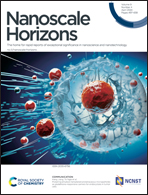Mechanism of photocatalytic CO2 methanation on ultrafine Rh nanoparticles†
Abstract
Selective hydrogenation of CO2 to yield CH4 relies on the appropriate catalysts that can facilitate the cleavage of CO bonds and dissociative adsorption of H2. Ultrafine Rh nanoparticles loaded on silica nanospheres were used as a class of photocatalysts to significantly improve the selectivity and reaction rate of producing CH4 from the mixture of CO2 and H2 under the illumination of a broadband visible light source. The intense light scattering resonances in the silica nanospheres generate strong electric fields near the silica surface to enhance the light absorption power in the supported ultrafine Rh nanoparticles, promoting the efficiency of hot electron generation in the Rh nanoparticles. The interaction of the hot electrons with the adsorbate species on the Rh nanoparticle surface weakens the C–O bond to facilitate the deoxygenation of CO2, favoring the production of CH4 with a unity selectivity at a faster rate in the presence of surface adsorbed hydrogen (H*). The systematic studies on reaction kinetics and diffuse reflectance infrared Fourier transform (DRIFT) spectroscopy under different conditions, including various temperatures, illumination powers, and feeding gas compositions, reveal the reaction mechanism responsible for CO2 methanation and the role of photoillumination.



 Please wait while we load your content...
Please wait while we load your content...